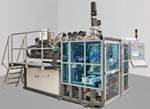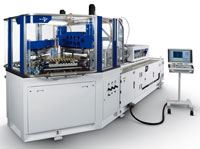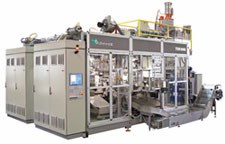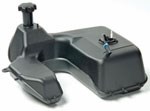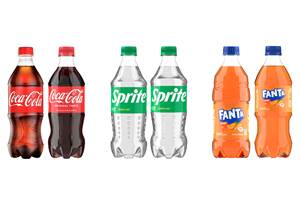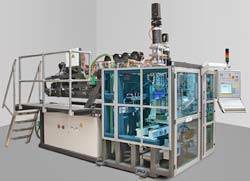NPE 2009 Wrap-Up: New Machinery for Blow Molding
Several new developments include a brand-new compression blow process, the first foamed PET bottles, and a preform decontamination approach for aseptically filled products sold at ambient temperature. Attendees also saw a new stack-mold Multi-Parting Line concept that doubles bottle output within the same machine footprint. (Additional NPE blow molding news appeared in May and June—see Learn More box.)
COMPRESSION BLOW DEBUT
A truly unique arrival at NPE was the first commercial Compression Blow Forming (CBF) machine from SACMI of Italy (U.S. office in Des Moines, IA). This continuous process extrudes a cylindrical rod of plastic, which is cut into discs that are placed in compression molds. The discs are molded into preforms and blown into bottles on a continuously rotating carousel. After compression molding the preform, it is blown in a second cavity by introducing air through the male plug. The cavity rises to form the bottom of the bottle. The neck finish is compression molded and there is no scrap or weld lines or injection gate vestige.
The concept was introduced at the K 2007 show in Germany (see Learn More) as a way to stretch-blow better PET bottles. While PET applications have not yet emerged, the first commercial CBF machine appeared at NPE on its way to make HDPE pharmaceutical bottles for Alcan Packaging in Caye, Puerto Rico.
Alcan’s 12-station machine molds up to 6600 bottles/hr. The 100-cc HDPE stock bottle weighs 12 g with a 0.8-mm average wall thickness and is molded (without stretching) in an 8.2-sec cycle for 5400 bottles/hr. An Alcan spokesman says the company foresees 30% to 35% energy savings over injection-blow molding, plus lightweighting through greater control of wall-thickness distribution, as well as better dimensional stability. The machine is also said to be mechanically simple and easy to maintain.
PET FOAM BOTTLES
As reported in June, a first in blow molding at the show was a foamed PET bottle/jar blow molding process using direct gas injection instead of a chemical foaming agent. Plastic Technologies Inc. (PTI) has developed the “oPTI” process for foaming PET bottles with the MuCell microcellular process licensed from Trexel Inc., Woburn, Mass. Nitrogen gas is mixed with the melt in a modified injection barrel on the preform machine. Foam bottles are pearly translucent to opaque in shades from white to silvery and even can have a brushed aluminum look. Light transmission can be reduced up to 95%. Foamed bottles do not contaminate the clear bottle recycling stream, and will produce clear bottles after reprocessing.
The part can be lightweighted up to 5% because the foam adds stiffness. Some foam containers reportedly can withstand hot filling without excessive shrinkage. Foaming also adds a non-slip surface and improves replication of details like embossed logos, PTI says. The oPTI process is also applicable to PEN and PLA.
Aoki’s new SBIII-500LL-50 (50-ton) hybrid injection stretch-blow machine uses hydraulics in functions that require large amounts of power, electric motors where speed is paramount, and pneumatics in other functions. The unit is designed for narrow-necked bottles (36 mm or smaller). It can produce approximately 35 million 16-g, 500-ml PET containers annually. Compared with Aoki’s hydraulic SBIII-500LL-75, the new model reduces the molding cycle up to 4%, production per hour is raised 22%, and power consumption is 18% lower.
The company also introduced its second smallest machine in the line, the SBIII-150n-12, a three station unit with a 12-ton clamp and max. shot of 150 g.
SIPA of Italy launched its SFL2 line of all- electric linear reheat stretch-blow molding machines in a two-cavity version capable of producing 6.6-gal PET containers with a 65-mm neck finish, or a single 10.5-gal container with an 85-mm neck.
A new entry from Krones allows packagers to produce their own hot-fill PET containers. Krones says the new NitroHotFill technology uses its newly developed “Relaxed Cooling” concept, where nitrogen injection just before the capper creates positive pressure of 1.5 to 2 bar inside the bottle. The pressure compensates for the shrinkage in product volume downstream of the recooler. This prevents bottle contamination caused by underpressure, and it eliminates the requirement to design bottles with panels or other features to compensate for vacuum pressure in hot-fill applications.
The Relaxed Cooling concept is used with Krones’ Contiform H stretch-blow machines, which produce up to 1600 bottles/hr per cavity in eight to 24 cavities. NitroHotFill with Relaxed Cooling reportedly reduces blowing and flushing air consumption, increases output, and can allow material savings up to 30% in bottle design. Air recycling with the Air Wizard IV helps to reduce air consumption further.
NEW ASEPTIC SYSTEM
Sidel’s Predis dry preform decontamination system, initially aimed at cold beverages, can now be used for aseptic filling of sensitive products sold at ambient temperature. One example is bottling of UHT milk. The Combi Predis FMa series for blowing/filling/capping in aseptic conditions combines Predis with Sensofill FMa, Sidel’s newest aseptic filling technology, in a single system. Bottle rinsing is replaced with dry preform sterilization with hydrogen peroxide vapor at the reheat oven entrance.
EXTRUSION BLOW NEWS
As reported in June, one of the novelties of the show was Bekum’s BM-406D double-shuttle continuous-extrusion machine with new Multi Parting Line (MPL) technology that doubles output capacity without changing machine footprint. It uses a special twin-row extrusion head from W. Mueller in Germany, paired with a stack-type mold from Fidelity Tool and Mold, Batavia, Ill. The mold has two independent parting lines that stay on the same centerline during mold open and close. MPL is available on Bekum’s H and BM Series shuttles and long-stroke machines.
Techne S.p.A. of Italy introduced two machines to North America. The one attracting most attention was its Advance ADV4/510 all-electric shuttle (described in June). It molded over 8000 bottles/hr while saving up to 35% on energy consumption compared with the most efficient hydraulic machines, according to Techne.
The firm also introduced the System 10000-S900 hydraulic single-shuttle coex machine. It is designed for up to six layers, including post-consumer regrind. Its 20-ton clamp and 900-mm stroke allow two cavities with 445-mm center distance or up to 14 cavities on 60-mm centers. Dry-cycle time is 2.9 sec.
Small blow molded multi-layer fuel tanks are a growing business, thanks to new EPA limits on fuel emissions. Kautex announced a new molding system for such tanks said to achieve 30% higher output with 30% lower energy use. Its new KBSmart series features a head optimized for lower throughput that reduces machine investment cost but can be used in 85% of small fuel-tank production today. The KBSmart 120 handles up to 50-liter tanks and has a maximum HDPE output of 1475 lb/hr. It features a Co-Ex-6 single clamp, robotic parison transfer, and a reduced footprint.
Meccanoplastica of Italy is now being represented in the U.S. by Alba Enterprises. Meccanoplastica produces continuous-extrusion shuttles (single- and double-sided) and the new Jet55 all-electric injection-blow system. The latter is a 50-ton, three-station machine for containers up to 150 ml. Two have already been sold in the U.S. Through a relationship with MBK (Maschinenbau Koetke) in Germany, Meccanoplastica also offers systems for small coex fuel tanks and suction blow molding of filler pipes and air ducts.
Two new reciprocating-screw extrusion blow molders from Uniloy Milacron are said to offer reduced energy use and shorter dry cycles. Its new R2000 neck-to-neck blow molding system is said to deliver nearly double the output of lightweight HDPE dairy bottles without increasing machine size. The system has higher clamp force (90 tons). The first two systems are in Russia, producing 6.5-g, 100-ml HDPE liquid yogurt containers at 20,000/hr. Uniloy Milacron’s in-house container and mold design capabilities helped the customer cut container weight 30% from 9 g previously. Uniloy Milacron also brought out the UR 65, a smaller machine for low- to medium-volume jobs.
WHEELS ROLL OUT
Wilmington updated its Series V wheel machines for larger bottles with new linear bearings for better platen guidance and a new bottle takeout/orientation system. A new clamp design and other features help to reduce the overall machine price 30%. It also has new remote Ethernet diagnostics. It produces containers from 2 to 10 liters in monolayer or coex structures with 12 to 30 stations running 2000 to 10,000 bottles/hr.
As reported in June, Graham Engineering introduced its Mini Wheel line with nine to 18 stations for coextruded containers.
Related Content
For Extrusion and Injection-Blow Molders, Numerous Upgrades in Machines and Services
Uniloy is revising its machinery lines across the board and strengthening after-sales services in tooling maintenance, spare parts and tech service.
Read MoreBreaking News From NPE2024
Here is a firsthand report of news in injection molding, extrusion, blow molding and recycling not previously covered.
Read MoreEnd-to-End Quality Management For Aseptic PET Beverage Bottling
Sidel introduces Qual-IS comprehensive quality system to merge all QC activities in PET aseptic beverage bottling, from the preform blowing to laboratory management.
Read MoreCoca-Cola’s Redesign of Small PET Bottles Pushes Lightweighting Below Prior ‘Floor’
Coca-Cola thought it had reached the limits of lightweighting for its small PET carbonated soft drink bottles. But a “complete redesign” led to a further 12% reduction.
Read MoreRead Next
NPE News in Blow Molding
While occupying a relatively small category of exhibits, blow molding will present no lack of innovation at NPE.
Read MoreCompression Molded PET Preforms Challenge Injection Molding
Lower cost, higher quality and productivity, and the potential for lightweighting beyond anything yet seen are benefits claimed for a new continuous compression molding process for making PET bottle preforms.
Read MoreNPE 2009 News Flash
Injection MoldingHybrid Press Has Electric ClampNew injection presses that combine servo-electric and hydraulic movements to achieve high performance with energy efficiency will be discussed by Arburg Inc., Newington, Conn.
Read More
